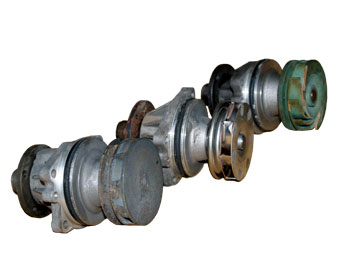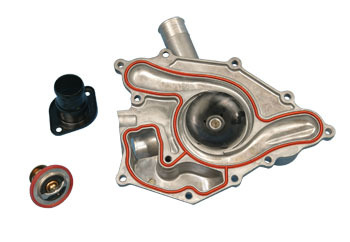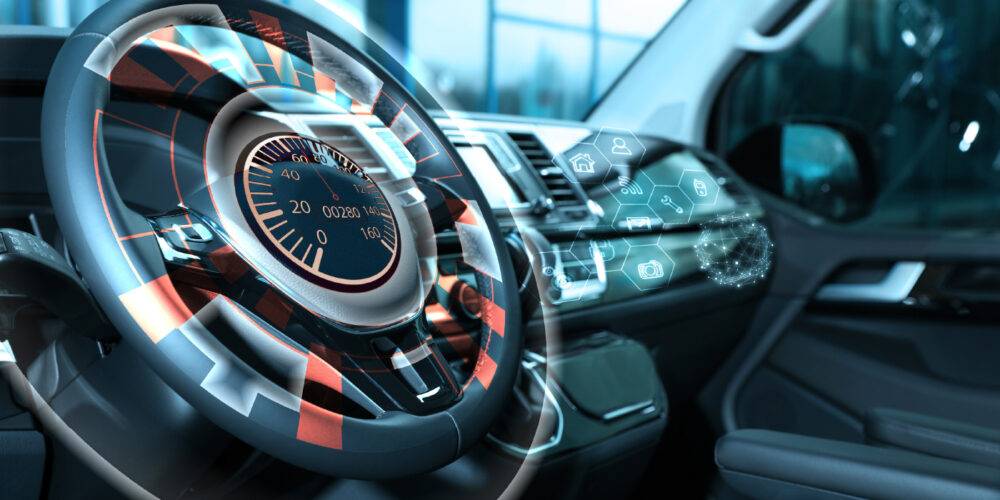 Did you know that up to a third of the heat energy produced inside an engine’s combustion chambers ends up as waste heat that goes into the block! This heat must be eliminated, otherwise the engine will overheat and self-destruct.
Did you know that up to a third of the heat energy produced inside an engine’s combustion chambers ends up as waste heat that goes into the block! This heat must be eliminated, otherwise the engine will overheat and self-destruct.
This is why the water pump, used to keep coolant circulating between the engine and radiator to get rid of the heat, is such an important component that should be checked along with the cooling system on regular intervals.
Because of the continuous load on the water pump — typically pumping several hundred gallons of coolant per hour at highway speeds — failures are not uncommon.
Pumping-Up Pumps
When you have started your career in the repair industry, make sure you talk with vehicle owners on the importance of a new water pump. Explain to them that replacing the water pump when doing a timing belt replacement will save the labor of having to do the job twice, should their current water pump fail down the road. (According to many water pump manufacturers, the service life of most water pumps averages between 100,000 and 150,000 miles.)
 Making an Inspection
Making an Inspection
The water pump is usually belt-driven and turns continuously while the engine is running. Most pumps are mounted on the front of the engine and are driven by a V- or serpentine belt. So you’ll want to make sure these belts are in good condition and have been replaced using the vehicle’s recommended guidelines.
Besides belts, coolant hoses also should be carefully inspected and replaced if any are found to be in less than perfect condition. Hoses that are brittle, aged, cracked, bulging or chaffed must be replaced. New clamps also should be recommended.
However, some water pumps are mounted under the timing belt cover on overhead cam (OHC) engines and are driven by the timing belt. A few are mounted on the back of the engine or head and are driven by the camshaft. A good guide for OHC engines that use the timing belt to drive the water pump is to first check the mileage on the original timing belt.
If the belt has been in service more than the OEM-recommended replacement interval (60,000 miles on older vehicles, and up to 100,000 miles on newer ones), it’s time that the timing belt should be replaced.
Typical Water Pump Failures and Causes
1. Leaking shaft seals: The most common water pump failure, leaky shaft seals, usually reveal themselves by leaving a coolant stain around the vent area. Unfortunately, shaft seal leaks can be difficult to diagnose because they can be intermittently temperature and pressure sensitive, and can be aggravated by rust and other particulate contamination in the system.
To diagnose a shaft seal leak, use a cooling system pressure tester to pressurize the cooling system. In most cases, however, the visual inspection is the most reliable method simply because most
intermittent shaft seal leaks are detectable only by the traces of coolant around the vent area and
surrounding parts.
2. Noisy shaft bearings: Most shaft bearings fail due to normal wear in the bearing or due to the normal oxidation of lubricant on the bearing surfaces. In rare cases, bearing failure can be hastened by over-tightening conventional accessory drive belts. In many cases, a water pump bearing also fails because it supports an unbalanced fan assembly that may also have bent or misaligned blades. Water pump bearings can also fail because an unknowing technician diluted the lubricant by washing the pump in a solvent tank.
3. Impeller slippage: Another water pump failure, though becoming more rare, is the impeller slipping on the water pump shaft. Since the impeller and shaft is a press-fit assembly, slippage occurs most frequently on remanufactured water pumps. In other cases where a plastic impeller is used, the plastic material can degrade through sustained heat and age. In any case, slippage can be intermittent in nature and can depend greatly upon the temperature and speed of the engine.
4. Rust corrosion: You may find that some replacement impellers may have been manufactured from inferior metals that are susceptible to rust corrosion. In most of these cases, impeller blades begin to break away from the impeller due to a rust-through condition, which results in decreasing pumping capacity and an increasing presence of rust contamination in the cooling system.
New Pump Precautions
1. Prior to installing a new water pump, make sure the replacement pump has the same mounting configuration, bolt locations and hose connections as the original.
Because of the variety in OEM pump configurations, you’ll also want to compare the fan or belt pulley flange height with that of the old pump. If the height isn’t to specification, belt alignment may be adversely affected.
2. To ensure the pump has the correct rotation, compare the impeller for similarity of configuration and size.
3. Make sure that the old gasket has been completely removed from the engine block in order to maintain correct tolerances between the pump impeller and engine block mount, which will prevent future leaks.
4. Before bolting the pump to the block, test for insufficient block clearance by holding the pump against the block and turning the impeller. When all dimensions and clearances have been checked, the water pump is ready for installation.
 Replacement Tips
Replacement Tips
1. Since most water pump failures are caused by leaking seals, it’s important to inspect the cooling system for the presence of abrasive rust or sand particles. In rare cases, the presence of dirt or loose core sand left over from casting the engine block may also cause repeated seal failure on water pump replacements, especially if the vehicle is driven on extended trips. Rust, in particular, will cause early seal failure because of its abrasive qualities.
Although rust is difficult to remove, it should be flushed from the system as thoroughly as possible before the old water pump is removed.
2. When performing a coolant flush, remember that adequate flushing is aided by removal of the thermostat, which allows for a maximum water pump circulation rate. It may even be time to replace the thermostat.
Overheating can damage the wax sensing element inside the thermostat, preventing it from opening properly at the right temperature.
3. Many vehicles require application-specific coolant to prevent corrosion in the cooling system and prevent premature water pump seal wear. Make sure you use the correct application-specific antifreeze when refilling the vehicle’s cooling system.
4. To prevent damaging the new water pump seal, make sure that the engine is completely filled with new coolant before starting the engine. With that done, always warm the engine until coolant circulates freely through the radiator and all air is bled from the system. Last, inspect for leaks and check the coolant level before releasing the vehicle to your customer.
Time To Flush
When a water pump is replaced, the cooling system should always be drained, flushed and refilled with a fresh mixture of antifreeze and water to restore proper cooling performance and corrosion protection. Just draining the radiator can leave as much as 50% of the old coolant in the engine block!











